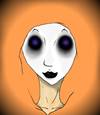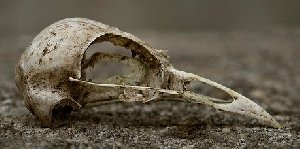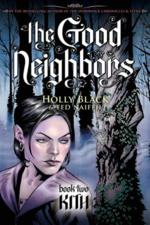 |
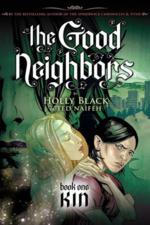 |
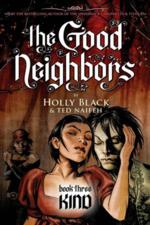
|
The Good Neighbors
Volume I: Kin
Volume II: Kith
Volume III: Kind
by Holly Black
Illustrated by Ted Naifeh
Graphix, 2008
Young Adult
![]()
![]()
Rue has always been able to “see things” out of the corner of her eye. Now the things have stopped hiding. Her friends, a group of urban explorers, discover a different kind of hidden world as vines begin taking over the city and people they know begin to disappear.
Holly Black’s faerie twist on Supernatural Romance is a quick read, not too deep, but great fun. There’s not much dialogue either, but that’s OK, because Naifeh’s art is so tasty. His fresh, simplistic renditions capture your interest and emotion. He depicts fae as not only elves and dwarves, but baphomet-looking fauns and other non-human bodies; he doesn’t try to fit the Seelie Court into a standard physical form that resembles Legolas.
The series is fairly tame in terms of horror, but there are grown-up themes and sexual situations, so its definitely young adult despite the graphic format. …and then, of course, there is that hideous thing with the cow skull at the end.
At the end of an investigation brought on by the false accusation of her father for murder, Rue discovers that her mother is a fairy, that she herself is half fairy, a small fact that had always been hidden from her. She first learns the story from her father Thaddeus: He rescued his wife Nia from her father’s unrelenting grasp using the old ways, a special riddle-challenge presented by Aubrey, her father. Later, we discover the Fairy version of the story as told by Aubrey. Rue’s father stole her mom away from the other realm, took away her freedom and choice. Noticeably, Nia’s viewpoint is never told.
Rue’s love interest lies in Tam, a servant of Aubrey who tries to help Rue whenever he can. We are never really sure of the truth of his statements, but he is human.
Now Aubrey has a plan to sever West City from the rest of the human world, to create a new Avalon. Humans are sacrificed, turned into trees, and worse is yet to come as the human residents realize their freedom is being stolen.
Humans aren’t toys. You understand that?
Oh… and there is a prophecy: “Only your own flesh can stop you.”
This causes Aubrey, in classic faery-tale fashion, to try to capture Rue, but of course, there is a trick to the interpretation. Aubrey eventually figures it out, to his team’s benefit.
A war between the races begins once the city is separated from the human world, and vines begin to take over. We see doppelgangers made out of branches and swan-skins stolen to enslave fae. During the conflict, Rue discovers she has the power to control plants.
As Rue learns more about her Fairy side, she begins to understand what makes both sides tick and get in touch with her own feelings while coming to grips with her father’s infidelity to her mother and the secret they kept from her.
You know how beautiful your mother is, how perfect. But perfection grows frightening with time. Your dad got older, got a gut and silver hair…his desire for her cooled as his discomfort grew.
Torn between two worlds, Rue makes a decision at the end. It is unexpected, but greatly satisfying.
If this were to find its way to film, I would envision David Bowie as Aubrey and Fairuza Balk as Rue.


